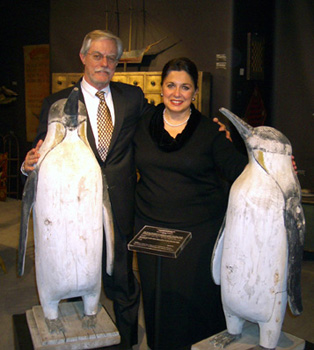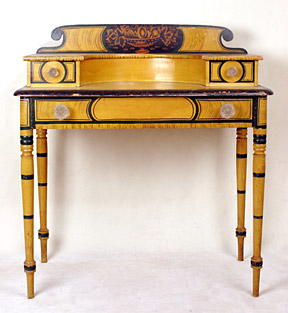Old Paint: Warmth and Patina of Painted Wares Entrances New Hampshire Couple
By Steven Marks

This life-size pair of carved and painted Emperor penguins were made to flank a doorway in a home in Essex, Mass. The 42-inch and 38-inch pieces sold for an undisclosed price. Asking price was $85,000.
Reprinted by permission from AntiqueTrader, March 24, 2004.
There's something truly intriguing about an original painted surface.
That subtle painting interplay of color, form and age -- whether it be on early 19th-century furniture or 20th-century folk art or decoys -- is what attracts dealers Russ and Karen Goldberger to the antiques gallery.
"We like objects to be as authentic and untouched as possible," said Russ Goldberger of RJG Antiques in Rye, NH.
"In terms of high country furniture and accessories, generallly they were objects that were painted when they were made," Goldberger said.
"Objects that retain their original paint in Fine condition are far more desirable in the minds of collectors," Goldberger said. "This is distinctly in conflict, however, with trends in the 1950s through the 1970s," he laughed.
"Then, we dip-stripped our furniture to get down to that wonderful knotty pine look," Goldberger lamented. "It destroyed the surfaces of an untold number of antiques and decoys."
The result? It's even harder to find the good stuff. But that doesn't deter the couple, who look for objects that "transcend their functional purpose."
Such was the case with decoys, which Goldberger -- co-author with Alan G. Haid of Mason Decoys: A Pictorial Guide -- began selling more than 25 years ago. Painted decoys were often repainted since they were used as a hunting tool under sometimes harsh conditions. Even back then, Goldberger emphasized decoys in his wholesale business that were "as close to original condition as you could find."
"With that training in what original paint looks like on wooden objects, it was a fairly smooth transition 15 years ago to expand our business to a full line of antiques while still retaining that emphasis on original paint," he said.

This chrome yellow decorated dressing table was made in Portsmouth, NH, around 1820-1830. The Goldbergers value the table at $13,500.
Goldberger and his wife then began building up their business in Pittsburgh while looking for a home in northern New England to set up a full-time business. After careers for both at Procter & Gamble and marketing positions at pharmaceutical companies, the former Air Force captain and his wife put down roots in Rye, NH.
Although they still specialize in decoys, American furniture and accessories, and folk art (all with original painted surfaces), many things have changed. Like others, but perhaps earlier, they built a Web site which features items they have for sale. They also take part in a number of shows, including The American Antique Show in New York City.
At this year's show, they sold a brightly painted, two-sided gameboard (Parcheese and checkers) for a "quite expensive" price, Goldberger said. In addition, they sold two life-sized carved Emperor penguins which starred on the local station's weather report during a bitterly cold week in the city.
Goldberger puts an equal emphasis on the aesthetic appeal of objects when he advises collectors.
"I've never encouraged people to invest in antiques or decoys if there wasn't a love that guided the investment first," said Goldberger, noting that there have probably been better means of investing over the last 10 years.
"If you love the objects, then I think it will pay everyday dividends," he continued. "And, when it's there to sell, you generallly come out making some money. You might not make a fortune, but you get all these objects for all those years rent-free, so to speak."
Goldberger has just bought back a decoy collection he sold piece-by-piece to a customer over the last 12 years. Even though RJG Antiques sells retail and buys back wholesale, the decoys had appreciated enough in value so that Goldberger "ended up paying the owner a nice premium over what he had paid."
Goldberger is an enthusiastic man with a deep boom in his voice. He described his wife, Karen, as "the friendly one with a great decorative eye."
"Karen makes it possible for the business to run," he added, noting she is "extremely good" at dealing with people.
As for his own love of painted surfaces, Goldberger said he did take some art classes but had no interest in oil painting or the like. His mother was an artist, so he grew up in an environment with an appreciation of color.
When asked if perhaps he painted houses when he was younger, he laughed deeply and said "Yeah, I've probably done that, but it's not something I ever enjoyed."
Still, there is that attraction to the patina of oil paint.
"I find that painted color clearly enhances form and makes for a far more desirable total object," he said.
"We try to find furniture and other objects with a certain sense of style which sets them apart."
Steven
Marks writes about arts, crafts, design and antiques as
well as the business of each.
Reprinted with permission from the March 24, 2004 issue of Antique Trader.